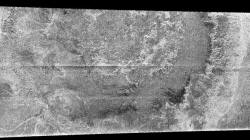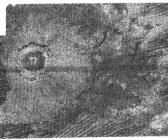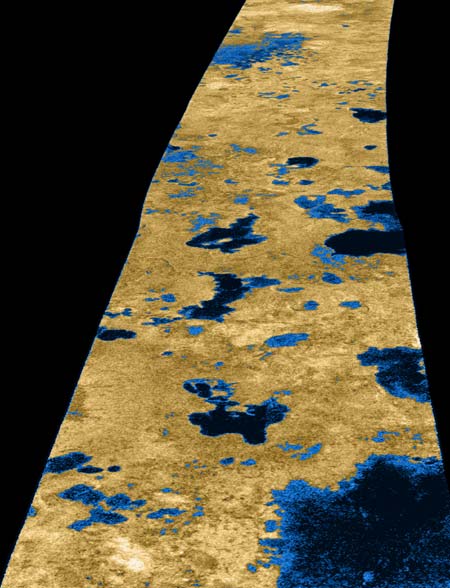|

by David Powell
Special to
SPACE.com
26 March 2007
from
Space Website
The Cassini spacecraft's
radar sweep of Saturn's largest moon Titan in January
revealed a portion of what appears to be a 110 mile (180 kilometer)
diameter impact crater.
If its impact origin is confirmed it would only be the fourth such
crater discovered on Titan, a surprisingly small number.
Impact cratering is pervasive in our solar system, and the number of
craters on the surface of a moon or planet can reveal its age in
just the same way the accumulation of potholes on a highway reveals
how long ago the asphalt was laid.
Earth's Moon remains heavily pockmarked because it has no
significant weather or geological processes to wipe its face clean.
Earth, similarly bombarded over the eons, shows many scars from
relatively recent impacts that have not had time to weather away.
Craters are common on several other satellites of Saturn.
"If Titan's surface
had the same density of craters that other Saturnian moons have,
there should be thousands of craters," said Ralph Lorenz
of the Johns Hopkins University Applied Physics Laboratory.
"With radar having examined about 10 percent of Titan's surface,
we have only three definite craters, and perhaps a half-dozen
probables."
Far too few
The trio of impact craters confirmed to date are named Menrva,
Sinlap and Ksa and have diameters of 273 miles (440
kilometers), 50 miles (80 kilometers) and 17 miles (28 kilometers),
respectively.
|
 |
 |
 |
|
The huge
impact crater Menrva was spotted by the Cassini
radar instrument on 15 February 2005 on Titan and has an
outer diameter of 440 kilometers. It resembles a large
crater or part of a ringed basin, either of which could
be formed when a comet or asteroid tens of kilometers in
size crashed into Titan. Credit: NASA/JPL
|
The
appearance of Sinlap crater and the extremely
bright (hence rough) blanket of material surrounding it
is indicative of an origin by impact, in which a
hypervelocity comet or asteroid, in this case, roughly
5-10 kilometers (3-6 miles) in size, slammed into the
surface of Titan. Credit: NASA/JPL
|
This image
from Cassini's radar instrument shows impact crater
Ksa, with a diameter of 30 kilometers (19 miles), on
the surface of Saturn's moon Titan. The difference in
overall appearance between this crater, which has a
central peak, and those without, such as Sinlap,
indicates variations in the conditions of impact,
thickness of the crust, or properties of the meteorite
that made the crater. The dark floor indicates smooth or
highly absorbing materials. Credit: NASA/JPL |
Titan's thick nitrogen
atmosphere hinders the formation of impact craters less than about
12 miles (20 kilometers) in diameter, because smaller space rocks
burn up before they reach the surface. This is one reason the
shrouded moon's crater count is so modest.
As Cassini continues to map up to 30 percent of Titan's surface at
radar wavelengths the crater tally is set to grow.
"We've seen three
craters on 10 percent of the surface, so we will probably find
another 10 to 30. Maybe there are 30-100 in total, although we
will need a follow-on mission to Titan to find and document them
all," Lorenz told SPACE.com.
Still, researchers
consider the surface nearly pothole free when it should be on the
road to ruin. Something yet to be determined must be keeping the
crater count down.
Buried
Clues to Titan's smooth finish can be seen in the presence of vast
tracts of sand dunes, river channels and evidence for cryo-volcanism
visible in Cassini images.
It is likely that a combination of burial in sand, erosion by
methane or obliteration by the cold hand of cryo-volcanism is
responsible for paving over the craters. Cassini has already spotted
vague circular features among Titan's sand dunes that may be
evidence of craters undergoing burial.
Pinning down the rate of crater removal will be an important factor
in dating the age of Titan's surface features, including those
craters that have survived.
"We have no way of
knowing how recent the known craters are, although Menrva is old
enough that it has a fairly eroded rim, cut by river channels,"
Lorenz said.
The road
toward life
Though craters are the most obvious legacy of impacts, these
dramatic events can leave much more than a hole in the ground.
Indeed, the shock of an impact can affect the atmosphere. In Titan's
case, a big blow can add ethylene to the mix and aid the conversion
of ammonia into molecular nitrogen.
Chemical reactions on Titan's surface might also be instigated by
impacts and though the craters may be few and far between, fresher
examples such as Ksa could be biologically interesting sites for
future missions to veer toward.
It's possible that for a brief period, the heat of an impact could
create liquid water on a moon that is otherwise icy cold.
"One of the most
exciting aspects about impact craters on Titan, is that by
melting a chunk of Titan's icy crust, it forms a local area of
liquid water on the surface, which can then chemically react
with all the photochemical organics drizzling down from the
atmosphere," Lorenz explained.
Such organics when
exposed to water in the laboratory have been seen to form the
prebiotic molecules essential to the formation of proteins and DNA.
"So in the thousands
of years it might take for this water to freeze, some very
interesting prebiotic synthesis can occur. No-one knows how
close to self-replicating chemical systems such environments
might get before they freeze solid. Perhaps by visiting Titan in
the future with a lander or balloon able to sample such material
we can find out," Lorenz said.
Saturn's Moon Titan a World of Rivers
and Lakes
by Ker Than
03 January
2007
from
Space Website

Images shot last summer by NASA's Cassini spacecraft provide the
strongest evidence yet that Titan, a saturnian moon and one of the
most Earth-like celestial bodies in the solar system (image
right), is dotted with a multitude of liquid lakes.
"At the time we
first announced it, we were like, 'Well, we think these are
probably lakes,' but that was about our level of confidence,"
said study team member Ellen Stofan of University College
London and Caltech. "I would say at this point, we've analyzed
the data to the extent that we feel very confident that they are
liquid-filled lakes."
Instead of water,
however, the Titan lakes [below image] are likely filled with
methane, and possibly even ethane, organic compounds that are gases
on Earth but liquid on the frigid surface of Titan.
"It's going to
behave like water," Stofan said about liquid methane. "It's
transparent just the way water is. So if you were standing by
the shoreline, you would be able to see down to whatever pebbles
or gunk that was on the bottom."

A false-color image
of Titan's surface snapped by NASA's Cassini spacecraft on July 22,
2006.
The lakes appear
darker than the surrounding terrain beca
Titan is the only moon
in the solar system to have a dense atmosphere with thin layers of
methane and nitrogen clouds - a
setup similar to that of early Earth.
Atmospheric methane is destroyed by sunlight over time and must
constantly be renewed. Scientists thus speculated that lakes or even
oceans of methane might exist on, or just beneath, the moon's icy
surface and that evaporation from these liquid bodies was
replenishing the atmosphere.
The first
confirmation of this thinking came last July (see below insert)
when Cassini's radar spotted more than 75 large, dark patches around
the surface of the moon's northern pole.
"The lakes are
basically black in the [radar] data, which is how a liquid would
behave," Stofan said.
|
Lakes Found on Saturn's Moon Titan
by
Robert Roy Britt
Senior Science Writer
28 July 2006
from
Space
Website
 One
of the major goals of NASA's Cassini mission was to find
lakes or seas on Saturn's moon Titan. One
of the major goals of NASA's Cassini mission was to find
lakes or seas on Saturn's moon Titan.
Now scientist say they've found lakes.
These are not bodies of water like those on Earth, but
rather dark lakes of methane and possibly ethane. They
are likely the source of the hydrocarbon smog in the
moon's atmosphere that has long made it impossible to
even see the surface.
Several dark patches, some with channels running out of
them, were spotted near Titan's north pole during a July
22 Cassini flyby, NASA said in a statement yesterday.
"This
is a big deal," said Steve Wall, deputy radar team
leader at NASA's Jet Propulsion Laboratory. "We've
now seen a place other than Earth where lakes are
present."
This was
Cassini's first look at the region. Its radar, which
penetrates the smog, was used to find several dozen
lakes ranging from less than a mile wide to one that is
about 62 miles long.
"What
we see is darker than anything we've ever seen
elsewhere on Titan. It was almost as though someone
laid a bull's-eye around the whole north pole of
Titan, and Cassini sees these regions of lakes just
like those we see on Earth," said Larry Soderblom,
Cassini interdisciplinary scientist at the U.S.
Geological Survey, Flagstaff, Ariz.
On radar,
dark areas indicate smoother terrain. These apparent
lakes are so dark that the scientists assume they must
be liquid. Any water on Titan would be constantly
frozen, however, so the assumption is these lakes are
made of hydrocarbons, which can stay liquid at much
colder temperatures.
The shapes of outflow channels strongly suggest liquid
carved them, the researchers say.
"We've
always believed Titan's methane had to be maintained
by liquid lakes or extensive underground 'methanofers,'
the methane equivalent of aquifers," said Jonathan
Lunine, a Cassini scientist at the University of
Arizona. "We can't see methanofers but we can now
say we've seen lakes."
Lakes
should change shape slightly with the seasons, and winds
ought to roughen their surfaces, so future passes by
Cassini will look for these effects.
Other Cassini observations have revealed apparent river
channels elsewhere on the moon, as well as shorelines
that might represent lakes or seas. Scientists say the
moon likely experiences methane rains.
But most observations, until now, have not shown
conclusively that the methane exists in large quantities
in liquid form now.
Cassini has been observing Saturn and its moons and
rings since it arrived there two years ago. It is a
cooperative project between NASA, the European Space
Agency and the Italian Space Agency. |
Radar data alone wasn't
enough, however. A very smooth deposit of fine soil would also
appear black on radar, Stofan explained.
The clincher that the patches were liquid lakes came from looking at
the surrounding terrain. Some of the patches appeared to be fed by
sinuous channels, or "rivers," some more than 62 miles (100
kilometers) long. Others appeared to be contained within rimmed
circular depressions, similar to crater lakes or volcanic calderas
on Earth.
"The morphological
evidence points completely away from it being a smooth deposit
of soil or sediment. It's just not consistent," Stofan said.
"Combining these two sets of data, it led us to feel very
confident about the interpretation that they're actually
liquid."
In a study published in
the Jan. 4 issue of the journal Nature, the researchers also suggest
that the rivers and lakes are being filled by rainfall from
methane clouds or by seepage from
beneath the moon's surface.
"You can think of
all the exotic words you want to call it--a 'methanofer' because
it's not an aquifer. It's a subsurface methane table and not a
water table," Stofan told SPACE.com.
The researchers predict
that as the seasons progress, lakes in the winter hemisphere should
expand while those in the summer hemisphere should shrink or dry up
entirely.
Cassini is slated to perform 22 more Titan flybys, the next of which
is scheduled for later this month.
Cassini's Latest
Discoveries

These three views of
Titan from the Cassini spacecraft illustrate how different the same
place can look in different wavelengths of light.
Cassini's cameras
have numerous filters that reveal features above and beneath the
shroud of Titan's atmosphere.
All of these images
were taken with the Cassini spacecraft wide angle camera on April
16, 2005,
at distances ranging
from approximately 173,000 to 168,200 kilometers (107,500 to 104,500
miles)
from Titan and from a
Sun-Titan-spacecraft, or phase, angle of 56 degrees.
|






 One
of the major goals of NASA's Cassini mission was to find
lakes or seas on Saturn's moon Titan.
One
of the major goals of NASA's Cassini mission was to find
lakes or seas on Saturn's moon Titan. 